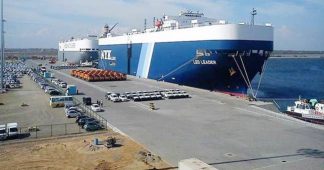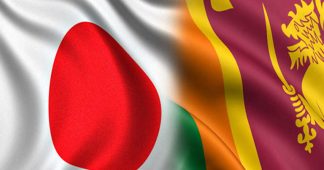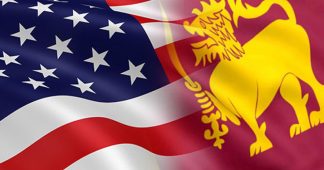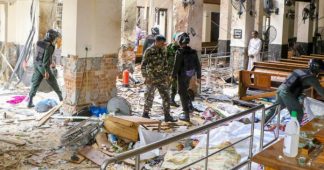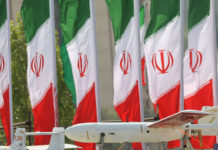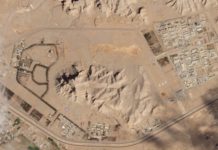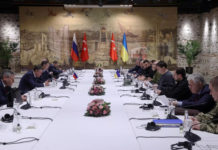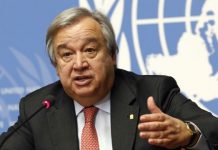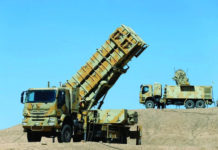By Darini Rajasingham-Senanayake
June 14, 2019
“Because the Indian Ocean is sort of the world’s energy interstate and China will have a maritime presence, perhaps even a naval presence in some distant morrow. So the opening of this port in south Sri Lanka is of real geopolitical significance.” ~ Robert D. Kaplan author of Monsoon[1]
Crime is essentially about meaning and semioticsis the ‘science of interpretation’ ~ Marcel Danesi
Six weeks after the Easter Sunday crime in Sri Lanka, it is an open secret among Colombo’s diplomatic community and intelligentsia that Saudi Arabia funded and had prior notice, while the United States had prime motive to stage the Hollywood-style “shock and awe” suicide attacks, mysteriously claimed by the Islamic State two days later. Sri Lanka is a 70 percent Buddhist county with around ten percent each of Hindus, Muslims and Christians, and hence the Euro-American, Christian-Islam “Clash of civilizations” narrative has little traction in the island –a detail that seems to have confounded the masterminds of the attacks on selected churches and luxury hotels in a carefully planned logistics operation.
The US had planned to sign the controversial Status of Forces Agreement (SOFA) after the attacks that effectively paralyzed and destabilized the country for weeks when acting Defense Secretary Patrick Shanahan would visit the island after the Shangri la Dialogue. SOFA would enable American troops to enter the strategically located Indian Ocean Island in an “emergency” such on Easter Sunday, which would be effectively rendered a servicing and logistics hub (code for military base), centered on the coveted Trincomallee deep sea natural harbor in the Eastern Province, which some ‘terrorism experts’ claim IS wants for its Caliphate. There is no evidence to suggest that IS has blue water ambition.
While many countries have lifted travel warnings seemingly confident that no more attacks are forthcoming six weeks later, in the streets of Colombo heightened anti-American sentiment is apparent: There is a sense that larger global forces are circling, playing and preying on the country. Thus, the English language Island newspaper on quoted award winning Naomi Klein’s “Shock Doctrine: the rise of Disaster capitalism” that describes how CIA tested economic and environmental “shocks” are administered to bend societies to the will of the American Empire and related business and security interests.[2]
As the shock of the Easter carnage ebbs in Sri Lanka questions regarding the motives embedded in the empirical detail and design of the crime have come to the fore. There is a growing divide between international expert narratives that claim IS was responsible and local perception that the US had a hand in the Easter attacks. Some commentators have suggested, following Tony Cartalucchi that: “the US deliberately created ISIS to serve as a pretext for illegally occupying Syria.. and will continue to use ISIS’ convenient expansion worldwide to justify a continued, global US military presence worldwide as well.”[3]
The insular and nationalistic general public of strategically located Ceylon/Sri Lanka, ‘islanded’ for generations by 450 years of European colonialism and post-independence Euro-American occupation of the Indian ocean, suddenly seems to be going through a steep learning curve regarding the country’s geostrategic and geopolitical futures asquestions are being raised as to who funds, owns and operates the shadowy IS network? Shocks and terrorists, economic and environmental Disasters, also provide opportunities for learning and growth– if only local and global political leaders who seem impervious to learning lessons would stand aside.
Trump’s Pivot to Asia and a Pattern of mysterious attacks
On the last day of 2018 President Donald Trump signed legislation designed to strengthen America’s role in the recently invented “Indo-Pacific”. The airily titled Asia Reassurance Initiative Act (ARIA) is the most comprehensive statement in a generation of America’s regional interests. It authorizes expenditures of $1.5 billion annually through 2023 to enhance U.S. military, diplomatic and economic engagement with East and Southeast Asian allies such as Japan, India, South Korea and Taiwan.
Retrospectively, the IS claimed attacks in Sri Lanka appear as part of a larger pattern of mysteriously triggered attacks and political unrest the South and Southeast Asian region at this time: 1) On February 15 there was an outbreak of near-war in Pulwama on the India-Pakistan Kashmir border during the run up to elections in India; 2) on April 21 Easter Sunday turned into a mysterious bloodbath in Sri Lanka and; 3) in May 22 post-election violence was unleashed in Jakarta, Indonesiaalthough the popular President Joko Widodo was re-elected with a wide margin. 4) unrest is on-going in Hong Kong at this time. As elections loom later this year in Sri Lanka there would certainly be more externally orchestrated attempts to promote Muslim-Buddhist dissention to de-stabilize the country and maintain the US backed (neo)liberal Prime Minister and his network in power.
Indonesia’s economy is South East Asia’s largest. By 2050 it is expected to be the fourth largest economy in the world, after China, India and the United States, according to PwC. According to BBC’s Karishma Waswani, Police suspected that behind the post-election violence in Jakarta was an attempt to incite anti-Chinese violence as Chinese investment had become a contentious issue in this election as President Joko Widodo had been courting Beijing to invest in much needed infrastructure in the country. Additionally, there has long been resentment against ethnic minority Chinese Indonesians perceive to be wealthier than ethnic Malay Indonesians.
These mysterious terrorist attacks with undertones of religiously inflected social unrest, along with rapid de-escalation in some of Asia’s most populous, multi-religious and culturally diverse South and Southeast Asian countries like India and Indonesia before and after elections framed Muslims as the “terrorists” and or miscreants. In many instances Chinese interests and partners emerge as targets in these mysterious attacks.
In the case of the Pulwama attacks in the absence of communication channels between India and Pakistan, U.S, Saudi Arabia and the United Arab Emirates played a role in ensuring the quick release of the IAF pilot, Wg. Cdr. Abhinandan Varthaman, thereby defusing the near war situation. Causing disasters and then providing humanitarian and peace building advice and assistance while selling advanced defense systems is a billion dollar US led global military-business-intelligence industrial complex.
All these attacks occurred in the lead up and following the long-anticipated landmark International Court of Justice (ICJ), ruling that the UK and USA must de-colonize the Indian Ocean’s Chagos Island, located south of the Maldives, where the secretive US military base Diego Garcia operates purportedly to ensure regional security and fight global terrorism.
Arguably, unlike the Obama administration’ ballyhoo “pivot” to Asia, Mr. Trump’s turn to the East seems darker — bellicose: Strategically located, Sri Lanka sits halfway between Iran and China in the Indian Ocean on one of the world’s busiest energy, trade, and global internet Undersea Cable Routes (UDC). Robert Kaplan termed it“the world’s energy interstate”. From post-Easter developments in the recently invented “Indo-Pacific” ocean, it appears that a United States led Cold War on China is slowly unfolding in the Indian Ocean at this time, as US war ships position themselves near Iran, and in the South China sea, and Donald Trump’s sanctions on Iran’s oil trade bite. There were attacks on ships in the area, the IS did not claim them. These attacks are attributed to Iran by ‘knowledgeable experts’.
The Rule of Experts and Weaponization of Religion
In the wake of the April disaster in Sri Lanka a fog of contradictory claims and narratives were crafted by international terrorism experts as to why IS had chosen Sri Lanka for its latest adventure – a deep dive in the Indian Ocean far from familiar mountain and dessert terrain.
It was suggest thatSri Lanka was 1) an “easy or soft target” due to co-habitation issues between PM and President although the county had comprehensively defeated the LTTE known as one of the deadliest terrorist group 10 years earlier; 2) the IS needed a publicity boost for its followers to “feel good” psychologically after defeats in Syria and Iraq at this time. 3) Sri Lanka President and police have been distracted by a sudden drug epidemic that mysteriously hit the country; 4) Islamic state was expanding and moving its caliphate to South and Southeast Asia and was pivoting to the Eastern Province of Sri Lanka.
However, as a Bangladesh security expert asked: why Sri Lanka and why not Nepal or any other country with dysfunctional and corrup leaders?Meanwhile, German and British intelligence experts suggested that the images and narratives attributing the attacks to IS were “staged” and the video of Al Bagdhadi talking about the attacks have been questioned by Arabic and French intel experts as audio tape had been imposed on the video, again raising questions regarding who is behind the IS narrative, and owns, operates and uses the IS, and who benefits?
Singapore-based expert Rohan Gunaratne, with known links to the US military business intelligence industrial complex claimed that IS has territorial ambitions to set up a “province of its Caliphate in Sri Lanka’s Eastern province where the Trincomalee deep Sea port coveted by USA for a military hub is conveniently located. Meanwhile a Rand Corporation expert and anthropologist, Jonah Blank, suggest that IS operates on a “franchise’ model – like a US corporation (Mac Donald’s or KFC?), to cause one off opportunistic adventures![4]Rand’s Blank, who is the author of “Mullahs on the main frame”, when interviewed about the terror attacks in Sri Lanka while in Indonesia as unrest was on-going there, provided insight on the US corporate model that the IS is based on. Blank also attempted to connect the Easter crime in Sri Lanka with attacks in New Zealand. However, the NZ Prime Minister Jacinta dismissed out right any connection between attacks on mosques in New Zealand the carnage in churches in Sri Lanka.
The Arch Bishop of Colombo, Cardinal Malcom Ranjith meanwhile seemed to hit the nail on the head when he talked about a “hidden hand” behind the IS narrative to spread Islamophobia and invite attacks on Sri Lankan Muslims to disrupt the peace, while questioning the general and vague claims that IS was responsible for the attacks in Sri Lanka. The IS narrative is a global grand narrative that has spread Islamophobia and anti-Muslim sentiment (like the “Clash of Civilizations” narrative), that was played in Sri Lanka although there is no history or motivefor Sri Lankan Muslims to attack Christians since both these religious communities are minorities in Buddhist majority Sri Lanka. We must hence look beyond local ethno-religious identity politics to external and geopolitical forces and actors to explain the enigma of IS attacking Christians in Sri Lanka.
Semiotics of a crime: China and Indian Ocean MDA
Examination of specific empirical material and analysis of the detail, design, timing and selection of targets of the attacks, as well as, motives evident in this carefully planned logistics operation point beyond the IS narrative. Moreover, if indeed IS was behind the attacks, questions remain as to funds, who owns and operates IS and uses and benefits from the IS narrative at this time? It is hence important to look beyond general and vague claims about IS to de-code the semiotics of the Easter Sunday Crime in Sri Lanka, by close examination of the targets chosen,out of numerous possible targets for 8 suicide bombers.
As the dust settles and more information comes to light almost 2 months after the Easter Sunday carnage in Sri Lanka, it is increasingly clear from the design, targets, theme and timing of the crime that China’s ambitious Belt and Road Initiative (BRI), as well as, maritime research co-operation were one of several motives for the crime.
In addition to the selected churches, suicide bombers hit three carefully chosen five star hotels, out of a line-up of six or seven on Colombo’s sea-front luxury hotel strip where tourists gather, indicating that this was also a planned and systematic attack on the country’s already debt trapped and currency manipulated economy. The Galadari and Taj Hotels that are located on the same Colombo sea-front luxury hotel strip that flank Shangri La Hotel escaped unscathed, as did other sea front hotels in the same strip – Galle Face Hotel, Hilton Hotel, and Ramada. The other two hotels that were targeted, the Cinnamon Grand and Kingsbury Hotels, were owned by local Sri Lankan conglomerates. John Keells which owns Cinnamon grand is building its latest Cinnamon Tri Zen property development with the China construction company.
The Hong Kong head-quartered, seafront Shangri la hotel was attacked with 2 suicide bombers, whereas the other sea front hotels and costal churches had one Suicide bomber—a fact that points to Shangri la being a prime targetfor the designers of the Easter carnage. Suicide bombers targeted coastal Christian churches with congregations whose livelihood is connected to Indian Ocean fisheries and marine resources and fisheries harbours were locked down soon after.
“Four Chinese researchers who were killed in the terror attacks in Sri Lanka last month were in the country as part of China’s Belt and Road Initiative (BRI), a vast infrastructure-building project to connect China to Europe and other parts of the world, according to Nature, the International Journal of Science.The four scientists were senior engineers from the South China Sea Institute of Oceanology in Guangzhou, and from the First Institute of Oceanography in Qingdao. Five other Chinese researchers were also injured, according to the Chinese embassy in Colombo.
The Easter suicide bombings happened 3 days before the Belt and Road Forum which was billed as the most important diplomatic event in China this year was scheduled to take place Beijing on April 25.Two weeks after the attacks in strategically located Sri Lanka the US tightened sanctions on Iran, removed sanction waivers, and moved its war ships into the Straits of Hormuz and South China sea – seemingly posturing at choking China, India and Sri Lanka which are dependent on Iranian oil.
No inland town, churches or hotels were targeted. The design of the attack, the venues picked, churches located among coastal communities with congregations whose livelihoods largely depend on fisheries and Indian Ocean resources in Colombo, Negombo and Batticaloa, as well as the targeting of luxury ocean front hotels, suggest a theme, as well as, a coded message from the masterminds of the carnage. Marine affairs and the ocean is a red thread that runs through the design and detail of the selected targets in the Easter Sunday crime in Sri Lanka. It would appear that the designers of the attack had an interest in Sri Lanka’s marine affairs, perhaps to draw a security cordon sanitaire around the strategically located Indian Ocean island that sits on top of major global energy and trade routes and crucial global internet Undersea Data Cables (UDC). After the attack and arrival of doves of intelligence experts and agencies the fisheries habours in the island were locked down. In other words, it would appear that the masterminds had an interest in Sri Lanka’s oceans and marine affairs; or, what the US ambassador in Sri Lanka termed, “Maritime Domain Awareness” (MDA), in a recent interview on Ada Derana TV regarding the United States’ Millennium Challenge Corporation (MCC), assistance for so-called ‘poverty alleviation’ to Sri Lanka.
No Such thing as ‘Indo Pacific’: Rising Asia must unite to de-colonize IO
The US “pivot to Asia” seems intended to stymie the rise of Asia at this time. The pivot is principally targeting China, but also South and Southeast Asia, and the rise of Asia’s 3 economic giants, China, India, and Indonesia, by any and all means, including, use of an old Cold War strategy of proxy war and weaponizing South and Southeast Asia’s highly divers, multi-religious and multicultural societies and politics and causing chaos in the region, particularly, Indian Ocean rim states.
The use of religion as “soft-power” along with the weaponization of religious identity politics though the IS narrative is one aspect of the US “pivot to Asia”. Indeed, there is a lot of evidence to suggest that IS, is funded owned and operated by Saudi Arabia and the CIA to do the dirty work of the crashing American Empire at this time — by dividing multi-religious and multicultural communities and destabilizing whole regions of the world as has happened in Middle East and Africa regions in order to loot their resources and sell weapons. [5]The Asian region must unite to ensure that this does not let this happen.
In addition to economic warfare, there has been a concerted propaganda war against China’s BRI initiative. However the Economist Magazine has suggested that BRI may be described as a “Marshall Plan without a war” for the global South, particularly, for debt trapped, and impoverished Asian and African countries as it focusses on much needed infrastructure building and enhanced connectivity for economic growth and trade. China after all was a leading member of the non-Aligned Movement during the Cold War between the United State and Soviet Union that lasted from 1947 to 1991, and a voice for the Global South. It is unlikely that the emerging superpower has forgotten its commitment to South-South Cooperation.
The United States upped the rhetoric on Indian Ocean ‘maritime domain awareness’ (MDA), and a “rules based Indian Ocean and free and open passage”, as it positioned air craft carriers in the Straits of Hormuz to tighten sanctions against Iran in the two weeks following the Easter carnage in Sri Lanka.The communique after visit of Sri Lanka Foreign Minister Marapona to Washington in May stated: “The United States and Sri Lanka resolved to work together to foster peace and security and ensure a safe maritime domain in the Indian and Pacific Oceans, through a rules-based order that ensures respect for international laws and norms.” In this context, the U.S. strategy towards a free, open, and prosperous Indo-Pacific region, which ensures freedom of navigation, overflight, and unimpeded commerce, was acknowledged as an important initiative.”
However, America is one of the few countries in the world that has not signed the UN Convention on the Law of the Sea (UNCLOS). While the US and some EU (NATO) partners talk about a “rules based” IO, they are the biggest violators of International Law as the ICJ ruling that the UK must de-colonize the Chagos Islands and return it to Mauritius and subsequent United Nations’ General Assembly vote 6 to 116 which showed the extent to which the UK and US are isolated in the Indian Ocean indicates. Just as de-colonization of Chagos Islands must end so too the Diego Garcia US military base and CIA Black site which is an ongoing human rights violation in the Indian Ocean must be closed down so that the Chagossians may return to their homeland.
The Chaggosian people have the Right to Return to their Island home and Asia united must stand up for them. US and EU talk a lot about a “rules Based” Indian Ocean and human rights but as the plight and struggle of the Chagossian show UK and US routinely violate human rights and International Law in the Indian Ocean. Chagos Islands has been effectively blacked out of the map of the Indian Ocean to keep this dirty secret; that the US and EU colonize and resource grab in the Western Indian Ocean (from the Coast of Africa to the Malabar), and have hegemonized the Indian Ocean is clear from the fact that most Asians have never heard of the Chagos Islands located just south of the Maldives.
The Indian Ocean and its resources are heavily over fished by French, Spanish, EU, Japanese, Korean and Taiwanese distant water fishing fleets (DWFS) at this time and threaten the livelihoods of impoverished IO coastal communities, and remains to be de-colonized.
India must join hands with other Asian and African Indian Ocean littoral states at this time to ensure de-colonization of the Indian Ocean, and roll back Euro-American imperialism, and looting of Indian Ocean resources living and non-living. The colonial status quo in the IO enable EU particularly France to use its former and present colonies, as well as , US’ Pacific Ocean partners (Japan, Korea), to overfish and loot IO resources and demand absurd quotas at the Indian Ocean Tuna Commission (IOTC).
In the final analysis, there are 3 main Oceans in the world – the Atlantic, Indian and Pacific Oceans. There is no such thing as an “Indo Pacific”, which is a geo-strategic concept that was invented as part of US pivot to Asia to legitimize installing its war machine in the Indian Ocean, causing extensive environmental pollution, while threatening and ironically pretending to protect a “rules based Indian Ocean” and the rise of Asian economies. US war ships and war machine are polluting the Indian Ocean and pose a marine environmental threat to the well-being of the environment and livelihood of many people of the IO. US should go back to the Atlantic and Pacific Oceans where it belongs rather than causing terror attacks, environmental disasters and then pretending to fight terrorism and do disaster preparedness and mitigation!
Back in 1970, the Non-Aligned summit in Lusaka, Zambia, declared that the Indian Ocean must be a ‘zone of peace from which Great Power rivalries and competition, as well as bases’ must be excluded. The United States had attacked this idea. Admiral Elmo Zumwalt told the US Congress in 1974 that the USSR stood atop the ‘central part of the West’s energy jugular down to the Persian Gulf.’ For that reason, the Indian Ocean – and Diego Garcia – has ‘become a focal point of US foreign and economic policies and has a growing impact on our security.’
It is also increasingly clear as the US Cold War on China and Asian economies is heating up in the Indian Ocean with American war ships moving into the Straits of Hormuz to implement sanctions on Iran on one side, and in the South China sea on the other side of Sri Lanka and South Asia. Hence, coordinated local, national and South Asian regional (SAARC, ASEAN and OAU), as well as international interventions by Indian Ocean Rim State and Asian regional countries would be needed, both, to reclaim the Indian Ocean, for her impoverished littoral communities from the United States, EU and their Japanese- Korean, Australian allies, and contain the United States move into the Indian Ocean..
In the context, China and India must now recognize that for Asian economies to rise, Asia must be united and stand together against American aggression and imperialism, on the one hand, and its fake intelligence, peace building , “disaster preparedness” activities, while on the other hand the US actively militarizes the Indian Ocean in the Cold War against China.
India must ensure that she is on the right side of history this time around and push to de-colonize and make the Indian Ocean ‘a zone of peace’. For too long India has been distracted fighting windmills, the partition divide inherited from British colonialism, passed on to NATO and the USA to fester in the post-colonial period and with its Asian neighbours including the rising giant following the US model, but should wake up to the fact that Asia must not be divided if it is to rise again.
Indian Ocean rim states may need to declare and affirm that:
1. The Indian Ocean belongs to the peoples of the Indian Ocean and must decolonized, and declared a Zone of Peace free from big power rivalry. India must take a lead role to reclaim the Indian Ocean that bears her name for the impoverished peoples of the Indian Ocean, ensure technology transfer to sustainably utilize IO resources, both living (fishery) and non-living (LNG, oil, rare earth minerals), in an equitable manner, and ban Distant Water Fishing States (DWFS) – France, Spain, EU, Japan Korea, Taiwan which do not belong in IO from over-fishing and destroying the Indian Ocean marine resources.
2. A united Asia must push back strongly against US military aggression, adventurism and fake IS terrorist attacks, such as the Easter Sunday Carnage. Given the technological and environmental challenges that equitable marine resource development and use pose, regional initiatives, as well as, State-led, investment in research and development of Indian Ocean resources (both live and non-living LNG and rare earth minerals), is necessary for sustainable developmentespecially in the context of the island’s geostrategic location in the Indian Ocean, which is emerging as a trade and resource competition hot spot is necessary.[6]
3. It would also be important to file an RTI request to find out and review agreements with DWFS and private companies that the Fisheries Ministry has to give access to Sri Lanka’s EEZ, while doing very little to scale up the national fisheries industry. There are over 30 such agreements.
4, In the first week of June 2019, there was an oil spill that came to Dehiwella and Wellawatta beaches in Colombo. The US is very good at causing man made and environmental “disasters” like wars, weaponized religious conflicts, and oil spills, and then sends its troops on so called ‘humanitarian missions’ to craft the narrative and clean up the disasters that it has organized, and or sell weapons and various technology systems to prevent future attacks. Disaster preparedness and related humanitarianism (“Disaster Capitalism” as Naomi Klein wrote the book “Shock Doctrine”), is big US business.
5. The so called de-mining of Sri Lanka in the north-east of the island for 10 years is an example of fake humanitarian activity by international actors interested in land grabbing and needs to be investigated.
6. Environmentalism like the fake trade figures and concessions (GSP Plus) is a discourse that is increasingly used and manipulated by EU ad US to control the ‘terms of trade’ and loot the global south by technologically advanced countries. Indian Ocean fisheries communities were planning a big protest against DWFS at the CITES conference in Colombo, aimed at controlling the terms of trade in Indian Ocean fishery. In May CITES was aborted also as fisheries communities of Sri Lanka and IO littoral states were organizing to safe-guard their fisheries resources in the Indian Ocean and take back their harbours from ADB and France.
7. According to its own study, in 2013 the Pentagon consumed fuel equivalent to 90,000,000 barrels of crude oil. This amounts to 80% of the total fuel usage by the federal government. If burned as jet fuel it produces about 38,700,000 metric tons of CO2. And the Pentagon’s figures do not include carbon produced by the thousands of bombs dropped in 2013, or the fires that burned after the jets and drones departed. Corporate media reports on alarming climate change and never mention the Pentagon’s carbon footprint.
8. The US embassy puts out Sri Lanka’s weather reports, and seems to control Lanka’s access to its own oceans through the use of various threats and disaster scenarios (including a strange ocean bourn drug epidemic that distracted Sri Lanka’s intelligence, as well as, air and cyberspace and constantly makes disaster predictions.
9. Indian and all African and Asian littoral communities must join hands to invest in institutional capacity building and technology transfer with a Road Map to upscale the fisheries sector and marine sector as a whole including harbour engineers, marine oil and gas exploration capacity, and ensure the requisite transfer of technologybut instead all the youth are going overseas to university.
10. Sri Lanka urgently needs an INTEGRATED national development policy strategy and MUST review all foreign aid funded projects in relation to domestic development priorities and policies in a transparent manner, and put on hold any projects that do not have demonstrable benefit to the country, including projects such as the oil refinery in Hambantota, Turkish barges for power generation or steel plan in Trincomalee – to service the foreign war machine sans Environmental Impact Analysis.
11. Also needed is a marine resources sector and development Policy and Master Plan – that integrates analysis and a road map to develop and up-scale ocean-related sectors such as: Fisheries, Trade and Logistics, Oil and Gas and rare earth minerals as in Pullmodai for sustainable use with best practices from the Extractive Industries Transparency Initiative (EITI), with sustainable marine ecosystem management as a cross cutting theme while SL navy protects EEZ resources with other IO rim states.
References
Trance Wahhabi Code
Indonesia
What the United States Did in Indonesia A trove of recently released documents confirms that Washington’s role in the country’s 1965 massacre was part of a bigger Cold War strategy.
[1]Robert D. Kaplan, 29 June 2012, on China’s port expansion in the Indian Ocean (Agenda), Stratfor interview.
[2]K.M Wasnatha Bandara, 2019 Indo American Aggression for Geopolitical control. http://www.island.lk/index.php?page_cat=article-details&page=article-details&code_title=205742
[3]Tony Cartaucchi 2019 Sri Lanka: How Saudi backed terror targeted China’s allies: https://www.mintpressnews.com/sri-lanka-how-saudi-backed-terror-isis-targeted-chinas-allies/258170/
[4]http://www.ft.lk/opinion/ISIS-didn-t-choose-Sri-Lanka–but–Sri-Lankan-group-chose-ISIS–RAND/14-678412Isis didn’t choose Sri Lanka but the Sri Lankan group chose IS.
[5]Wahhabism spread at behest of the West during Cold War: Bin Salman..
https://tribune.com.pk/story/1672777/3-wahhabism-spread-behest-west-cold-war-mohammed-bin-salman/
[6]Japanese experts study coastal erosion in Sri Lank” with British experts http://www.sundaytimes.lk/190224/news/japanese-experts-study-coastal-erosion-in-sl-337720.html

